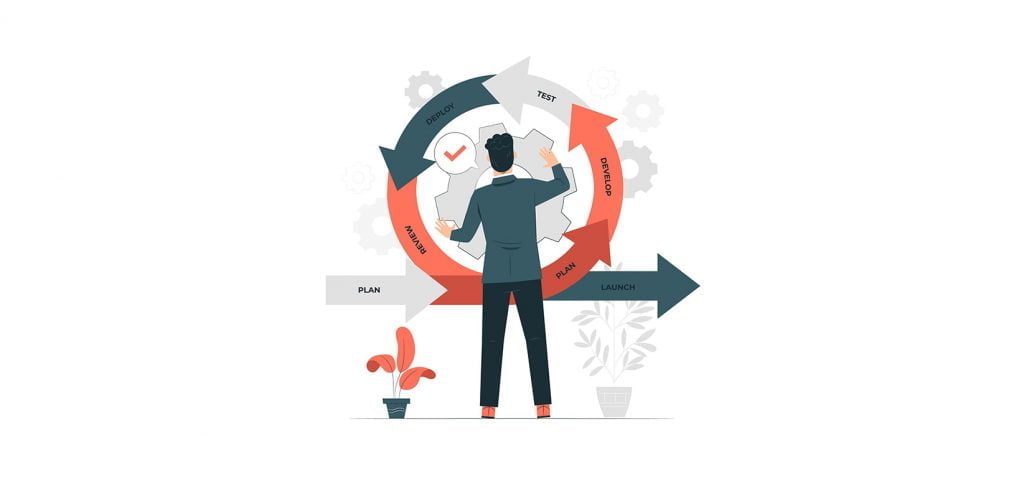Agile and Scrum Methodologies: Getting Ready for an Interview

Hello, friends! I hope your coffee is hot, and you're ready to dive deeper into the world of Agile and Scrum. This article is aimed at those who are looking to prepare for an interview on Agile and Scrum topics, as well as to explain how these methodologies are utilized in the IT industry.
Agile is an approach to software development based on flexibility, interactivity, client involvement, and continuous improvement. Scrum is one of the Agile methodologies that organizes team work around short, intensive work cycles called sprints.
Basics of Agile and Scrum
Agile started its development in the mid-1990s in the software development industry, where the need for quick adaptation to changing requirements and technologies became critical. Traditional waterfall development models, which required extensive planning and were slow to change, no longer coped with the rapidly evolving reality.
In 2001, a group of software development experts gathered at a resort hotel in the mountains of Utah, USA, to discuss these issues. This gathering led to the creation of the “Agile Manifesto,” which represented a set of principles for more flexible and adaptive software development. Since then, Agile has been evolving and applied in various industries and business domains.
Principles of Agile
- Customer satisfaction through early and continuous delivery of valuable software is the highest priority.
- Changes in requirements are welcomed, even in the late stages of development. Agile processes enable the use of changes to provide the customer with a competitive advantage.
- A working product should be delivered frequently, with a preferred frequency of a couple of weeks to a couple of months.
- Business partners and developers must work together throughout the development process.
- Projects should be built around motivated individuals. It is necessary to create an environment, provide information, and empower them to work.
- The most efficient way of conveying information within a team is face-to-face conversation.
- A working product is the primary measure of progress.
- Agile processes promote a sustainable pace of development.
- Continuous attention to technical excellence and good design enhances flexibility.
- Simplicity – the art of minimizing the amount of work.
- The best architectures, requirements, and designs emerge from self-organizing teams.
- The team should regularly reflect on ways to improve its effectiveness and adjust its working style accordingly.
A Brief Description of Scrum as One of the Agile Approaches
Scrum was first introduced in 1986 in an article by Hirotake Takeuchi and Ikujiro Nonaka in the “Harvard Business Review”. The article described a new approach to project management that was more akin to a rugby team working towards a common goal rather than a traditional waterfall model.
However, Scrum, as we know it today, began to take shape in the 1990s through the work of Ken Schwaber and Jeff Sutherland. They structured Scrum, presenting it as a project management framework, and in 1995, they jointly introduced their model at the OOPSLA conference.
Since then, Scrum has become one of the most popular Agile frameworks used in software development.
Scrum is a framework methodology that transforms complexity into simplicity through short, iterative cycles of improvement called sprints. This model involves the participation of all project stakeholders in planning, collaboration, and reporting on the work accomplished.
Key Terms and Concepts in Scrum
Scrum encompasses numerous terms and concepts that help organize the development process. Here are some of them:
- Scrum Team: The Scrum team consists of the Product Owner, Scrum Master, and development team.
- Product Owner: The person responsible for managing the product backlog and ensuring the product's high value.
- Scrum Master: The team member who ensures adherence to Scrum processes, helps the team work more effectively, and removes impediments.
- Development Team: A group of professionals working on creating and testing the product.
- Product Backlog: A list of everything that needs to be done for the product. The Product Owner manages the backlog and determines task priorities.
- Sprint: A defined time period (typically 2-4 weeks) during which the team works on selected tasks from the backlog.
- Sprint Backlog: The set of tasks selected for execution in the current sprint.
- Daily Scrum (or Stand-Up): A short (usually no more than 15 minutes) daily meeting where the team discusses progress and plans for the day.
- Sprint Review: A meeting at the end of the sprint where the team demonstrates completed work and receives feedback.
- Sprint Retrospective: A session held after the Sprint Review where the team discusses what went well, what didn't, and how to improve the process in the next sprint.
- Increment: The result of work completed during a sprint, a functional addition to the product that is ready for use.
- Definition of Done (DoD): A list of criteria that must be fulfilled for a task or product to be considered done.
- User Story: A concise description of product functionality from the user's perspective. It usually includes a user role, goal, and reason.
- Epic: A large unit of work that can be broken down into multiple smaller tasks or user stories. Epics are often used to describe complex features or high-level changes.
- Velocity: A metric that indicates the amount of work the team can complete within one sprint. It is usually measured in story points.
- Story Points: An estimation of task complexity. It is a relative measure used to assess the complexity of work, rather than the time required to complete it.
- Burn-Down Chart: A chart that shows how much work is remaining during a sprint or project.
- Impediment: Any obstacle or problem that hinders the team's effective work.
- Refinement (Grooming): The process of reviewing and refining the product backlog, including task estimation and prioritization.
- Timeboxing: The time constraint set for completing a specific task or activity. In Scrum, all events (Daily Scrum, Sprint Planning, Sprint Review, Sprint Retrospective) have strict time frames.
- Scrum Board: A visual board (often in the form of a Kanban board) that displays the work progress in the current sprint. It can be divided into sections such as “To Do,” “In Progress,” and “Done.”
- Sprint Zero: A sprint used for planning and preparation before the start of a project. It may involve developing important artifacts such as the product backlog.
- Release Planning: The process of planning product releases over time. It may involve defining key features to be included in each release and determining when those releases will occur.
- Stakeholder: Any person or group with an interest or involvement in the project or who may be affected by its outcome.
- Acceptance Criteria: Specific conditions that determine when a task is considered complete and a feature is ready for use.
- Spike: A time-boxed task aimed at exploration or addressing uncertainty. A spike can be used to research a new technology or develop a prototype.
- Technical Debt: A metaphor describing the consequences of choosing quick but potentially unreliable solutions that may require more time for fixing or maintenance in the long run.
- Product Increment (PI): The sum total of all product backlog items completed during a sprint.
These are not all the terms, but they provide a good understanding of the key concepts in Scrum.
The Role of a Developer in Agile and Scrum
Responsibilities of a Developer in a Scrum Team
A developer in a Scrum team has several responsibilities:
- Designing and implementing product features.
- Participating in sprint planning and selecting tasks from the backlog.
- Collaborating with other team members to solve complex problems.
- Participating in daily Scrum meetings and sprint retrospectives.
How to interact with other team members
It's important to remember that Scrum is not just about processes; it's also about people. Learning to work as a team and being ready to help your colleagues is an essential part of working in Scrum. It's also important to communicate effectively with the Product Owner to understand product expectations and requirements, and with the Scrum Master to help improve the team's work.
Simply knowing the Scrum terminology is not enough. Employers want to see that you understand and can apply Agile and Scrum principles. You need to demonstrate that you can work as a team, be flexible and adaptable to change, and respect Agile values.
Tips for preparing for an interview
1. Understand Agile and Scrum
An interview for a developer position in a Scrum team is not only about testing technical skills but also about assessing your understanding of Agile and Scrum methodology. Make sure you know the core principles of Agile, as well as the specific elements of Scrum, such as roles, artifacts, and events.
2. Ability to apply Scrum
Simply knowing the theory of Scrum is not enough. You need to demonstrate that you can apply Scrum in practice. Think about projects where you have used Scrum and be prepared to talk about them.
3. Understanding Agile Values and Principles
Agile is people-oriented and emphasizes collaboration, so it's important to demonstrate that you share these values. You may be asked to discuss a situation where you applied these principles in practice.
4. Knowledge of situational questions
Prepare for situational questions related to Agile and Scrum. For example, “What would you do if you had to make significant changes to a project in the middle of a sprint?” or “How would you communicate with a team member who disagrees with the task estimation?”
5. Answers to common questions
Prepare answers to typical Agile and Scrum interview questions, such as “What is Scrum?” or “Can you explain Agile principles?” Be prepared to give clear and concise answers. Familiarize yourself with all the key terminology.
6. Technical skills
Don't forget about your technical skills. You may be asked questions related to programming, software architecture, version control systems, and other technical aspects.
7. Preparation for teamwork questions
Scrum is a team methodology, so you are likely to encounter questions about teamwork and collaboration. Be prepared to discuss your experience working in a team, your achievements, and how you handled conflicts or challenges.
8. Continuous learning and development
The IT and technology world is constantly evolving, and Agile emphasizes the importance of adaptability and learning. Be prepared to discuss how you continue to develop as a professional, what Agile and Scrum books you have read, what courses you have taken, what certifications you have obtained.
9. Problem-solving
You may be given a problem-solving task or a case study related to Agile and Scrum. This is a good opportunity to demonstrate your practical understanding of the methodology and how it can be applied to achieve goals and solve problems.
10. Active participation
Remember that the interview is also your chance to learn more about the company, its culture, and how it applies Agile and Scrum. Don't be afraid to ask questions and be an active participant in the conversation.
Preparing for an Agile and Scrum interview requires a deep understanding of concepts and principles, as well as practical experience in their application. Dedicate time to preparation, and you will be able to successfully pass the interview and demonstrate your value as an Agile developer.
Common Misconceptions about Agile and Scrum
1. Agile = No plan
Many mistakenly believe that Agile implies the absence of a plan. In reality, Agile emphasizes the importance of flexibility and continuous adaptive planning. There is a plan in Agile, but it is dynamic and can change in response to evolving needs and circumstances.
2. Everything can change at any moment in Scrum
This is another common misconception. While Scrum does support flexibility, changes in work during a sprint should be minimized. This helps the team focus on sprint tasks and achieve sprint goals.
3. Scrum Master = Team leader
A Scrum Master is not a traditional “leader” or “manager.” It is more of a facilitator role, helping the team properly apply Scrum. Scrum Masters help remove obstacles and create conditions for effective team work, but they do not manage the team in a traditional sense.
4. Agile and Scrum are suitable for any project
While Agile and Scrum have many advantages, they are not always the best choice for all projects or organizations. Some projects may require a more formalized approach or be better suited for other project management methodologies.
5. Every member of a Scrum team should do everything
In Scrum teams, members often work on different tasks, but this does not mean that everyone should be experts in everything. While it is important to have some diversity of skills and the ability to support each other, it does not mean that every team member should be an expert in all areas.
Common Mistakes of Developers in Scrum Teams
1. Lack of communication
Scrum heavily relies on active and open communication. Without it, the team may face coordination problems, task execution issues, and misunderstandings. If you do not communicate actively or share information, it can lead to problems.
2. Ignoring Agile principles
Some developers focus on the technical side of the work, forgetting about the principles and values of Agile. This can lead to situations where processes become “too important,” and the essence of Agile is lost.
3. Inefficient use of Scrum meetings
Scrum meetings, such as Daily Scrum, Sprint Planning, Sprint Review, and Sprint Retrospective, are meant to provide transparency and improve team efficiency. However, if these meetings are perceived as mandatory routines rather than tools for facilitating work, they can become a waste of time.
4. Lack of respect for sprint boundaries
Developers may try to add more work to a sprint than is feasible or change tasks in the middle of a sprint. This can lead to work overload and a decrease in quality.
5. Avoiding responsibility
In Scrum, the responsibility for sprint success lies with the entire team. If developers avoid this responsibility or try to shift it onto others, it can undermine trust and team effectiveness.
6. Dependency on the Scrum Master
Developers may rely on the Scrum Master as a traditional manager, expecting them to solve all problems. However, in Scrum, the team should be self-organizing and independently solve problems.
Situational Problem Scenarios and Their Solutions in the Context of Agile and Scrum
These examples can help you better prepare for an interview where you may be asked similar situational questions. It is important to remember that in Agile and Scrum, there are no “one-size-fits-all” answers, and your solutions may depend on specific circumstances.
Scenario 1: Sprint Deadline Missed
Situation: You are working in a Scrum team. The sprint is already 50% through its duration, but you discover that half of the planned tasks have not yet started. It seems that the team will not be able to complete all the planned tasks by the end of the sprint. What do you do?
Solution: First, you need to identify why the delay occurred. Perhaps the task estimation was too optimistic or unforeseen issues arose. Then, discuss the situation in the Daily Scrum and propose reconsidering the scope of work for the current sprint. It may be worth moving some tasks to the next sprint. This will allow the team to focus on the most prioritized tasks and successfully complete the sprint.
Scenario 2: Team Opinion Contradicts Stakeholder Opinion
Situation: Your Scrum team believes that using a specific technology stack would be more effective to achieve one of the project goals. However, the stakeholder insists on using a different technology stack. What do you do?
Solution: First and foremost, openly discuss this issue with the stakeholder. Explain your viewpoint and present arguments in favor of the technology stack chosen by the team. If the stakeholder still insists on their preference, try to find a compromise solution. It is important to remember that in Agile, the priority is to create value for the customer, and sometimes that may require making concessions.
Scenario 3: Constantly Changing Requirements
Situation: You are working on a project where requirements are constantly changing, making sprint planning and task estimation challenging. What do you do?
Solution: This is a common situation in Agile. In such cases, it is important to maintain constant communication with the client or stakeholder. If the requirements change, be flexible and revise and replan tasks accordingly. It can also be helpful to use change management techniques and conduct frequent feedback sessions.
Scenario 4: Low Team Productivity
Situation: You have noticed that the productivity of your Scrum team has decreased. Tasks are being completed slower than usual, and the team is not meeting sprint goals. What do you do?
Solution: You need to identify the cause of the productivity decline. It could be a result of motivation issues, work overload, team conflicts, or other problems. Start by discussing the situation with the team. Then, you can apply various techniques to improve team performance, such as conducting sprint retrospectives, practicing pair programming, or enhancing communication.
Scenario 5: Lack of Product Backlog
Situation: Starting a new project, you discover that your product lacks a product backlog, making planning and organizing work challenging. What do you do?
Solution: First and foremost, work with the Product Owner or the client to develop a product backlog. This should be a priority since without a backlog, it is difficult to plan sprints and manage the team's work. Once the backlog is created, you can start planning sprints and organizing the team's work.
Conclusion
Preparing for an Agile and Scrum interview requires understanding the principles and practices, as well as the ability to demonstrate their application. It is important not only to know the answers to typical questions but also to understand how to apply Agile and Scrum in practice.
I hope this article has helped you gain a better understanding of these methodologies and prepare for interviews.
P.S. Any additional comments, suggestions, and thoughts on the topic of this article are always welcome 💬
Recommend0 recommendations





Responses